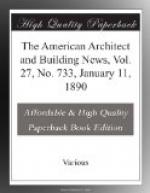Such a mill floor and columns, while possessing in a very high degree features which offer resistance to the fire, being weakened by the temperature only to a slight extent as they are slowly burned away under the exposure to a very severe fire, also possess the merit of great economy, both as regards the low price of construction, and in that the floor is thinner in comparison with joisted floors of equal strength, saving in this respect, for every floor in a building, about ten inches in height of wall, stairs, belting, steam-pipes, and all vertical connections reaching from floor to floor, a saving which amounts to considerable in the total cost of a building.
The division of mills into various portions by means of fire-walls is frequently not so efficient as assumed, by reason of the lack of fire-doors to satisfactorily fulfil the purpose of resisting fire. The best form of fire-door is that made of two thicknesses of matched boards, placed at right angles to each other and nailed together, being covered on the outside with tin, securely locked together and held to the door by numerous hanging-strips. The door should be secured to the hangers by means of bolts, and not screws, and the rail upon which it runs strongly bolted to the wall. When closed, such a door should fit into a jamb and be securely held in this manner against the wall. Such doors are frequently hung upon an inclined track, and, by some application of highly fusible solder at the catch, are so arranged that they will be closed by the heat of a fire, if not closed by hand.
In this treatment of the arrangement of buildings to resist fire, consideration has not been given to the cost of land, which is, of itself, an important factor in determining what arrangement will be the most expedient for an establishment. Where land is expensive, or there are limitations in the space suitable for building, it is frequently necessary to build mills and shops higher than would be warranted by good judgment under other conditions; but where circumstances will permit it, the one-story mill has been very successful, not merely in immunity from fire, and very low cost per square foot of floor, but also in the advantages of manufacturing, particularly in regard to cost of supervision and movement of the stock in process of manufacture. These are questions which must be determined, not merely in regard to the various processes of manufacture, but the individual needs of each concern; the position of the fire-risk in the matter being that the hazard of a building increases very rapidly with its height, and to some extent with its area.
The extension of one-story buildings over too large an area will not be commended, and certainly, as regards the question of fire, it has a tendency to place too large a property in direct exposure to a very wide hazard.




